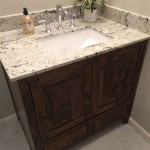How To Clear A Clogged Bathroom Sink With Baking Soda
A clogged bathroom sink is a pervasive household problem that disrupts daily routines and can quickly become a source of frustration. While professional plumbing services offer a definitive solution, understanding and implementing simple at-home remedies can often resolve common clogs effectively and affordably. Among these remedies, baking soda stands out as a gentle yet powerful cleaning agent with the potential to dissolve obstructions and restore proper drainage. This article provides a comprehensive guide to using baking soda to clear a clogged bathroom sink, detailing the necessary steps, safety precautions, and alternative methods to ensure a successful outcome.
Before initiating any clog-clearing procedure, it is crucial to identify the severity and nature of the blockage. Minor clogs might involve slow drainage, characterized by water pooling in the sink for an extended period. More severe clogs can result in complete blockage, with water refusing to drain altogether. The type of material causing the clog also influences the appropriate course of action. Common culprits include hair, soap scum, toothpaste residue, and small objects accidentally dropped into the drain. This preliminary assessment helps determine the most effective approach and prevents potential damage to the plumbing system.
Gathering the necessary materials is the next essential step. Baking soda (sodium bicarbonate) is the primary ingredient. White vinegar is used in conjunction with baking soda to create a chemical reaction that helps loosen the clog. Hot water is used to flush the drain after the baking soda and vinegar treatment. A plunger can be used to apply pressure to the drain, further dislodging the blockage. A screwdriver may be needed to remove the drain stopper or components of the P-trap, if necessary. Rubber gloves protect hands from exposure to drain debris and cleaning agents. Eye protection, such as safety glasses, is recommended to shield eyes from potential splashes.
Preparation is also vital for a smooth and efficient process. The area around the sink should be cleared of any clutter or obstructions. A bucket or container should be placed beneath the P-trap to catch any water or debris that may spill during disassembly. Adequate ventilation is crucial, especially when using vinegar, as the fumes can be irritating. Reading and understanding the following steps ensures that the procedure is carried out safely and effectively, minimizing the risk of damage or injury.
Key Point 1: The Baking Soda and Vinegar Method
The baking soda and vinegar method is a widely recognized and effective technique for addressing many common bathroom sink clogs. This approach leverages the chemical reaction between these two household ingredients to break down organic matter and loosen stubborn blockages within the drainpipe. The technique's success hinges on the precise application of baking soda and vinegar into the drain, followed by a period of soaking and flushing.
First, remove any standing water from the sink. Excess water dilutes the baking soda and vinegar mixture, reducing its effectiveness. Use a small container or sponge to remove water efficiently. Measure one cup of baking soda and carefully pour it down the drain opening. Ensure that all of the baking soda enters the drainpipe, as any remaining on the sink surface will not contribute to the clog-clearing process. Next, measure one cup of white vinegar and slowly pour it down the drain on top of the baking soda. The combination of baking soda and vinegar immediately triggers a chemical reaction, producing fizzing and bubbling. This reaction is evidence that the mixture is actively working to break down the clog. Allow this mixture to react for at least 30 minutes, or preferably overnight for tougher clogs. This extended soaking period allows the mixture to penetrate and dissolve the obstructing material more effectively.
After the soaking period, pour a kettle or pot of boiling water down the drain. The hot water helps to flush away the loosened debris and further break down any remaining residue. Exercise caution when handling boiling water to avoid burns. Observe whether the water drains freely. If the water drains slowly or not at all, repeat the baking soda and vinegar process. Multiple applications may be necessary for particularly stubborn clogs. If the clog persists after several attempts, consider alternative methods, such as using a plunger or checking the P-trap.
This method is generally safe for most plumbing systems, but it is important to avoid excessive force or pressure when pouring the baking soda, vinegar, or hot water. Overly aggressive application can potentially damage older or more fragile pipes. If you have concerns about the integrity of your plumbing system, consult a qualified plumber before proceeding.
Key Point 2: Utilizing a Plunger
A plunger is a fundamental tool for addressing sink clogs, functioning by generating pressure to dislodge obstructions within the drainpipe. While the baking soda and vinegar method aims to dissolve the clog, a plunger mechanically forces the blockage to move, either breaking it up or pushing it through the drainage system. Different types of plungers exist, but a standard cup plunger is typically effective for bathroom sinks.
Ensure there is enough water in the sink to cover the cup of the plunger. If necessary, add water to achieve the appropriate level. The water creates a seal, allowing the plunger to generate the necessary pressure. Position the cup of the plunger directly over the drain opening, ensuring a tight seal. Apply firm, steady pressure to the plunger, pushing down and pulling up without breaking the seal. Repeat this plunging motion vigorously for several minutes. The repetitive pressure can dislodge the clog and allow water to drain. Occasionally, lift the plunger to check if the water is draining. If the water drains slowly, continue plunging. If the water remains stagnant, proceed to the next step. If the sink has an overflow opening, it needs to be covered to prevent air from escaping, which reduces the plunger's effectiveness. Use a wet cloth or your hand to cover the overflow opening securely.
If the plunger is unsuccessful in clearing the clog after several attempts, consider combining it with the baking soda and vinegar method. First, perform the baking soda and vinegar treatment, allowing it to sit for the recommended time. Then, after pouring boiling water down the drain, use the plunger to further dislodge any remaining debris. This combined approach often provides a more powerful solution.
It is important to be mindful of the force applied when using a plunger. Excessive force can potentially damage older or weaker pipes. Use a controlled, steady plunging motion rather than forceful, erratic movements. If you suspect that your plumbing is fragile or corroded, consult a professional plumber before using a plunger.
Key Point 3: Inspecting and Cleaning the P-Trap
The P-trap, a curved section of pipe located under the sink, is designed to trap debris and prevent sewer gases from entering the bathroom. However, this design also makes it a common location for clogs to accumulate. Inspecting and cleaning the P-trap can be an effective way to remove stubborn blockages that are not resolved by baking soda, vinegar, or plunging.
Before disassembling the P-trap, place a bucket or container underneath to catch any water or debris that may spill. This prevents mess and protects the surrounding area. Loosen the slip nuts that connect the P-trap to the drain pipes. Use a wrench if necessary, but avoid over-tightening, as this can damage the nuts or pipes. Carefully detach the P-trap from the drain pipes. Be prepared for water and debris to spill out as you disconnect the trap.
Once the P-trap is removed, thoroughly inspect it for any visible clogs. Use a wire or hook to remove any debris, such as hair, soap scum, or other materials. Rinse the P-trap with water to ensure it is completely clear. Inspect the drain pipes connected to the P-trap for any signs of blockage. Use a flexible tool, such as a plumber's snake, to reach into the pipes and remove any debris. After cleaning the P-trap and drain pipes, reassemble the P-trap, ensuring that the slip nuts are tightened securely but not over-tightened. Run water into the sink to test the drainage and check for leaks. If there are leaks, tighten the slip nuts further or replace them if they are damaged.
This procedure involves handling potentially unsanitary materials from the drain. Wearing rubber gloves is essential to protect hands from bacteria and contamination. Proper disposal of the collected debris is also important to prevent the spread of germs. If you are uncomfortable disassembling the P-trap, consult a professional plumber. They have the expertise and tools to safely and effectively clean the P-trap and address any underlying plumbing issues.
In summary, clearing a clogged bathroom sink with baking soda is a viable solution that can often resolve common drainage problems. The baking soda and vinegar method, combined with the use of a plunger and the inspection and cleaning of the P-trap, provides a comprehensive approach to addressing various types of clogs. By following these steps and taking necessary precautions, homeowners can effectively maintain their plumbing systems and prevent costly repairs.

How To Clear A Clogged Sink Drain With Vinegar Baking Soda

How To Clean Drains With Baking Soda And Vinegar Liquid Plumr

How To Unclog A Sink The Experts Simple Steps Drain

Never Clear A Blocked Sink With Baking Soda And Vinegar Use This Instead

How To Unclog A Sink With Baking Soda And Vinegar

Baking Soda Cleaning Method For Hair Drain Clogs Part 2 My Buddy The Plumber Electric Heating Air

How To Unclog Your Bathroom Sink 5 Diy Solutions

How To Unclog A Sink 5 Natural Easy Ways Kitchen Cabinet Kings

Why You Should Never Use Baking Soda And Vinegar To Clean Clogged Drains

How To Clear A Clogged Sink Drain With Vinegar Baking Soda
Related Posts







